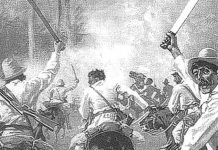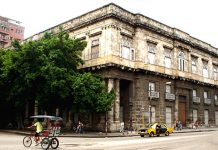
Contents
The Missile Crisis or October Crisis and its history.
The October Crisis or Missile Crisis, was the political and military conflict between the United States, the Soviet Union and Cuba, during the month of October 1962.
World peace was threatened by this conflict caused by the presence of Soviet nuclear missile bases in Cuban territory discovered by a US U-2 spy plane.
On October 15, 1962 the missiles were discovered and on October 28 of that same year the dismantling and transfer of the rockets back to the Union of Soviet Socialist Republics (USSR) was announced.
Although the so-called Missile Crisis is understood between both dates, nevertheless it spread almost until November 1963 in successive mini-crises.
Operation Anadir
The maneuver that became the trigger for the October Crisis was called Anadir. It was a secret military operation, carried out by the Soviet Union, to deploy ballistic missiles, bombers, and a mechanized infantry division toward Cuba.
The objective was to create a force capable of preventing and defending the island in the event of an invasion by the United States.
On May 29, 1962, a Soviet delegation arrived in Cuba that proposed to the revolutionary government to install nuclear-charged rockets, to prevent the invasion and strengthen the positions of Socialism in the world. General Issa Pliyev was in command of the operational command of this military force in Cuba.
Between June and October 1962, 24 launch platforms, 42 R-12 rockets, some 45 nuclear warheads, 42 Il-28 bombers, a regiment of 40 MiG-21 fighter jets, two anti-aircraft defense divisions, and four regiments arrived in Cuba. mechanized infantry and other military units. Around 47,000 soldiers were mobilized in total.
Nikita Khrushchev, President of the USSR, ordered that everything be done in absolute secrecy, unlike Fidel Castro, who requested publicity. Operation Kama was also arranged to send four Soviet submarines loaded with nuclear torpedoes and install a naval base.
This operation was a failure, the Soviet ships were detected by American ships.
The developing crisis
Upon discovering the installation of the missile bases by a North American spy plane, CIA analysts warned President John F. Kennedy that the structures photographed in Cuba that were not yet operational would soon be operational.
This became a concern for the US government for the proximity to the American territory. If a conflict occurred, they would leave the US defense unanswered and battle early warning systems.
Thus on October 22, 1962, Kennedy addressed the Americans through television and spoke for the first time in public about establishing a quarantine and a naval siege around Cuba.
Starting on October 23, American warships and aircraft were deployed in the Caribbean Sea to exercise a true air-naval blockade.
For his part, Nikita Khrushchev sent a message to Kennedy the following day, stating: “The USSR sees the blockade as an aggression and will not instruct ships to deviate,” but Soviet ships slowed down towards Cuba and thus avoid any conflict greater and open negotiations between the parties.
As a consequence, the Organization of American States (OAS) under pressure from the United States, imposed sanctions on the Cuban government and established the naval blockade in an operation called Quarantine to prevent the arrival by sea of resources that would favor the development of the bases mentioned.
The navies carried out a combined operation. The Argentine destroyers, Espora and Rosales, participated, becoming part of the combined US-Latin American fleet, Task Force 137 under the command of Rear Admiral D. John A. Tyree.
The Venezuelan destroyers ARV D-11 Nueva Esparta and ARV D-21 Zulia, the Dominican frigates Santana and Luperón, the destroyer USS Mullinix were also integrated.
Black saturday
A war seemed to be brewing. On October 26, the Soviet government sent Washington D.C. a personal message from Khrushchev to Kennedy to reach an agreement: Soviet ships would withdraw if the US government released a public statement renouncing the overthrow of the Fidel Castro regime and offering not to sponsor any war attack to that end.
That same day, Fidel Castro, from Havana, wrote a message and asked Khrushchev that in the event of a US invasión, the USSR would launch a nuclear strike against the USA, even at the cost of disappearing Cuba and starting a nuclear war.
On Saturday, October 27, 1962, also called Black Saturday, the Soviet anti-aircraft defense activated its radar system for the first time and shot down the US U-2 type spy plane by a surface-to-air missile when it was spying on the east of the island.
Talks
This further increased the tension, but that same day Khrushchev proposed to Kennedy to dismantle the Soviet bases, he was concerned about the possibility of Cuban unilateral action and stated so in the response letter on October 28 in Cuba, in exchange for the formal and public guarantee that the United States would not carry out or support an invasion of Cuban territory.
They also proposed the dismantling by the United States of its nuclear missile bases located in Turkey and the withdrawal of the PGM-19 Jupiter medium-range ballistic missile that they maintained in southern Italy.
Secret negotiations in Washington and Moscow continued, excluding Fidel Castro, and the Soviet government refused to consult with Cuba on the issue.
In the first days of November, US air espionage showed the world the Soviet ships that loaded the deployed nuclear weapons and that accredited compliance with the agreement of October 28.
At the end of November the naval patrols around Cuba ended, and two days later the Russians informed Cuba that the Soviet military presence would continue but only equipped with conventional weapons, the Soviet Union withdrew all its nuclear weapons and the medium-range ballistic missile from the island.
Consequences of the Missile Crisis
Of this fact, in addition to the tensions of all the inhabitants of the three nations involved in the crisis, the demolition of a North American plane and the death of its pilot are added.
The so-called red telephone, a direct line of communication between the White House and the Kremlin, was created to streamline talks between the two powers during periods of crisis and thus avoid diplomatic delays and correct potential misunderstandings on the issue of nuclear missiles.
Also during this brief time the existing political and ideological conflicts between the United States and the Soviet Union increased.
Curiously dark events
The main protagonists did not last long after the crisis. The President of the USA In the USA, Kennedy was assassinated on November 22, 1963, and the leader of the Soviet Union, Nikita Khrushchev, was removed from office by the Communist committee on October 14, 1964.
History recognizes this event as the most dangerous moment in the history of humanity.







